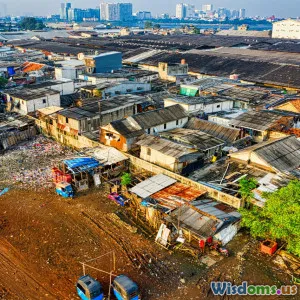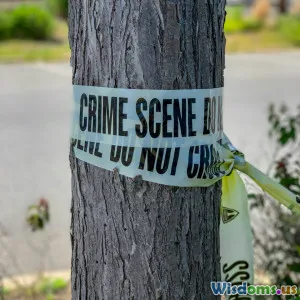
Why Urban Inequality Fuels Youth Gang Involvement
9 min read Exploring how urban inequality drives youth gang involvement and what communities can do to address this critical issue. (0 Reviews)
Why Urban Inequality Fuels Youth Gang Involvement
Urban inequality is a silent crisis shaping the lives of millions of young people worldwide. But beyond statistics and policy jargon lies a gripping reality—young individuals often find themselves pushed toward gangs as a response to the stark disparities surrounding them. Why does inequality in urban environments ignite youth gang involvement, and how can we begin to address it?
In this article, we'll delve into the complex relationship between urban inequality and youth gangs, unpacking historical context, socio-economic factors, structural barriers, and community dynamics. Armed with data and real-world examples, we’ll shed light on the pathways that funnel vulnerable youths into gangs and explore potential avenues for meaningful intervention.
Understanding Urban Inequality: More Than Just Income Gaps
When we speak of urban inequality, it's tempting to think only of economic disparity. However, urban inequality encompasses a spectrum of interlocking factors that includes:
- Economic Hardship: Persistent poverty, lack of wealth accumulation, and limited access to quality jobs.
- Educational Inequity: Under-resourced schools, overcrowded classrooms, and limited educational opportunities.
- Housing Segregation: Concentrated poverty and residential segregation often along racial lines.
- Access to Services: Unequal availability of healthcare, mental health services, and social support systems.
A 2020 report by the Urban Institute highlights that urban neighborhoods with concentrated poverty experience multi-dimensional deprivation affecting nearly every aspect of daily life. These conditions form fertile ground for disenfranchisement and frustration among youth.
The Link Between Urban Inequality and Youth Gang Involvement
There is no single cause of youth gang involvement; youth join gangs for various reasons including family, identity, protection, and economic survival. Yet urban inequality stands as a fundamental driver, shaping and intensifying these reasons.
Economic Desperation and the Quest for Survival
In neighborhoods where legitimate employment opportunities are scarce, gangs often fill the vacuum left by the formal economy. According to the National Gang Center, urban areas plagued by high unemployment and underemployment see higher youth gang membership rates.
For example, consider Baltimore's experiences during downtown job collapses. Young people, sometimes barred from entry-level jobs by systemic barriers, turn to gangs for financial means.
Educational and Social Exclusion
Schools in underserved urban areas face challenges such as overcrowding, lack of qualified teachers, and insufficient resources, resulting in academic underachievement and dropout rates significantly higher than suburban counterparts. When youths feel marginalized by the educational system, gangs can offer an alternative sense of belonging and identity.
Dr. Elizabeth Redmond, a sociologist specializing in youth behavior, notes, “Schools are often the first place where children in poverty feel denied opportunity. Gangs step in to provide support, albeit with dangerous consequences.”
Neighborhood Violence and the Cycle of Fear
High-crime urban neighborhoods often exist in a cycle of violence and fear. Youth join gangs for protection, to escape victimization, or to gain respect. A 2019 study in Chicago revealed that 70% of youth gang members reported joining initially for safety reasons. This points to a neighborhood climate where insecurity breeds gang affiliation.
Diminished Social Capital and Community Fragmentation
Social capital—relationships of trust and mutual support—is eroded in many marginalized urban environments due to economic pressures, housing instability, and family disruption. Gang networks sometimes substitute fractured community ties, offering a surrogate support system.
Case Studies Illustrating the Impact
Los Angeles and the Crenshaw Divide
In LA’s Crenshaw District, decades of segregation and economic disparity have culminated in entrenched gang culture. The area's youth gang activity reflects a legacy of disinvestment and lack of opportunity. The Los Angeles Police Department reports that neighborhood economic revival and community programs correlate with reductions in gang recruitment rates.
London’s Tower Hamlets: A Global Parallel
Urban inequality fuels youth gang involvement beyond the US. London's Tower Hamlets borough has seen gang-related activity intersect with inequality in housing and education. Initiatives focusing on community cohesion and youth engagement—such as mentoring schemes and improved schooling opportunities—demonstrate promising results.
Breaking the Cycle: Paths Toward Prevention and Intervention
Understanding the roots of urban inequality is urgent to disrupt the cycle leading youths into gangs.
Educational Investment and Equal Opportunity
Increasing funding for urban schools, ensuring equitable teacher allocation, and early intervention programs targeting at-risk youths have proven effective. For instance, Chicago’s "Great Kids, Great City" initiative, with improved afterschool programs and school support services, has made measurable headway in reducing dropout and gang involvement rates.
Economic Empowerment and Job Creation
Creating accessible employment pipelines for urban youth through apprenticeships, vocational training, and collaborations with local businesses reduces economic desperation. New York City’s Youth Employment Program showcases how structured, paid training opportunities can deter youth from gang recruitment.
Strengthening Community Infrastructure
Initiatives to rebuild social capital through community centers, recreational programs, and family counseling can disrupt pathways into gangs. The Boston Gun Project was enhanced significantly by community-based outreach, facilitating dialogue between communities and law enforcement.
Policy Reform and Comprehensive Approaches
Combating urban inequality means addressing systemic racism, biases in law enforcement, and housing policies. Countries like Norway exemplify success by integrating social policies aiming at equality, which correlate with low youth involvement in gangs.
Conclusion: Addressing Urban Inequality to Redirect Futures
Youth gang involvement is a symptom, not a root cause. Urban inequality—manifested in economic hardship, educational exclusion, and fragmented communities—creates conditions ripe for gang affiliation.
Addressing this complex issue requires a multi-faceted approach focused on equity, opportunity, and community empowerment. Through informed policy, targeted programs, and holistic community engagement, it is possible to dismantle the foundations of gang involvement and build resilient urban landscapes where youth can thrive outside of gangs.
As Michelle Alexander, author of "The New Jim Crow," eloquently put it: “To change the character of a community, one must begin by changing the conditions that allowed it to deteriorate.” Tackling urban inequality is the starting point to fostering safe, healthy environments that inspire hope rather than desperation for the next generation.
References
- Urban Institute (2020). Concentrated Poverty in Urban Areas.
- National Gang Center, U.S. Department of Justice.
- Chicago Study on Youth Gang Safety (2019).
- Los Angeles Police Department Gang Unit Reports.
- "Challenges and Opportunities in Urban Education" - Sociological Review.
- Boston Gun Project and Community Outreach Initiatives.
- "The New Jim Crow" by Michelle Alexander.
This article aims to enhance understanding, inspire policy makers, community leaders, and citizens to comprehensively address the root causes of youth gang involvement through reducing urban inequality.
Rate the Post
User Reviews
Other posts in Crime and Society
Popular Posts

















